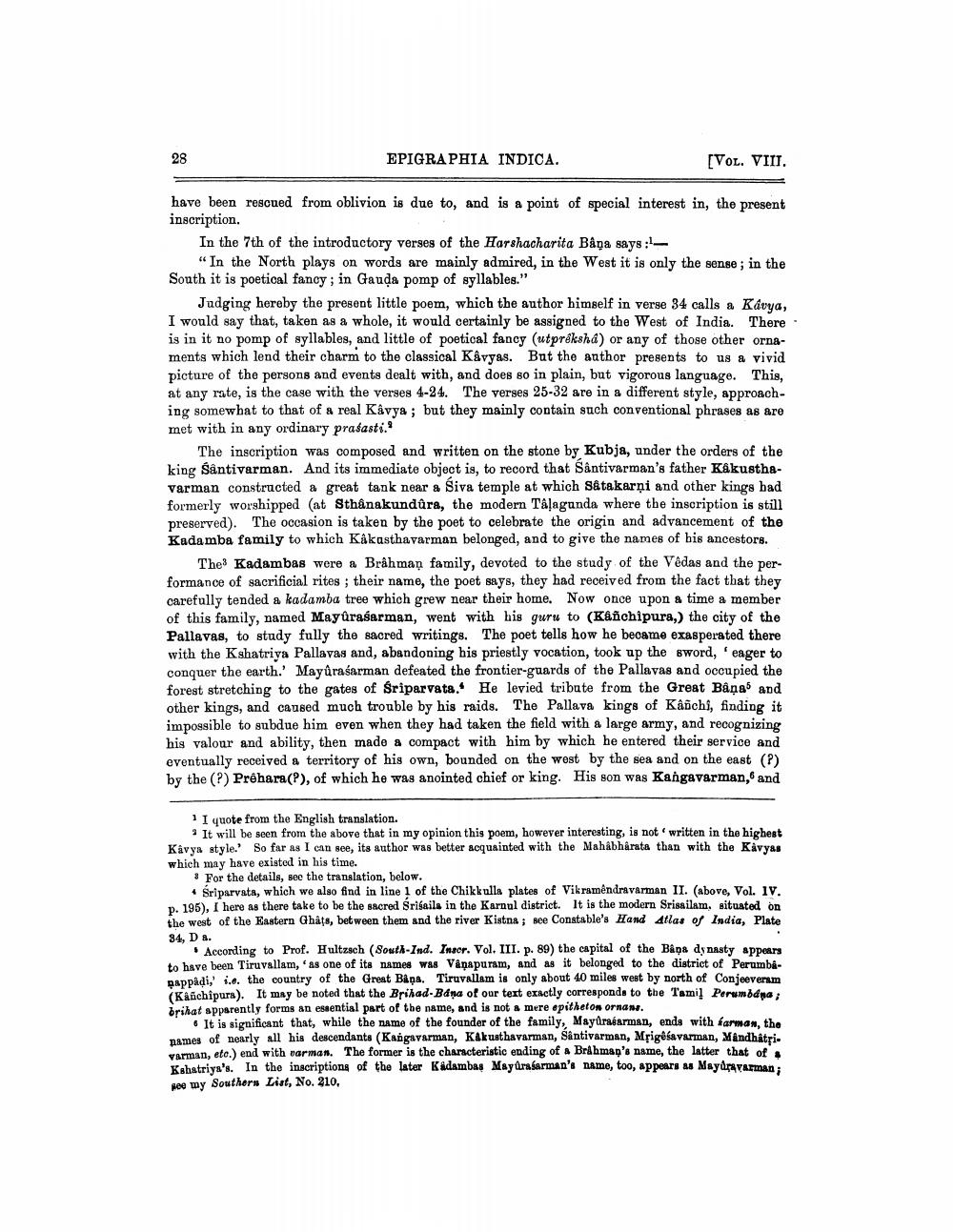________________
28
EPIGRAPHIA INDICA.
[VOL. VIII.
have been rescued from oblivion is due to, and is a point of special interest in, the present inscription.
In the 7th of the introductory verses of the Harshacharita Båna says:
"In the North plays on words are mainly admired, in the West it is only the sense ; in the South it is poetical fancy; in Gauda pomp of syllables."
Judging hereby the present little poem, which the author himself in verse 34 calls a Kavya, I would say that, taken as a whole, it would certainly be assigned to the West of India. There is in it no pomp of syllables, and little of poetical fancy (utprekshå) or any of those other ornaments which lend their charm to the classical Kavyas. But the author presents to us a vivid picture of the persons and events dealt with, and does so in plain, but vigorous language. This, at any rate, is the case with the verses 4-24. The verses 25-32 are in a different style, approaching somewhat to that of a real Kavya ; but they mainly contain such conventional phrases as are met with in any ordinary prasasti."
The inscription was composed and written on the stone by Kubja, under the orders of the king Santivarman. And its immediate object is, to record that Sântivarman's father Kåkusthavarman constructed a great tank near & Siva temple at which Satakarņi and other kings bad formerly worshipped (at Sthånakundûra, the modern Tâļaganda where the inscription is still preserved). The occasion is taken by the poet to celebrate the origin and advancement of the Kadamba family to which Kåkasthavarman belonged, and to give the names of bis ancestors.
The Kadambas were a Brâhman family, devoted to the study of the Vedas and the performance of sacrificial rites; their name, the poet says, they had received from the fact that they carefully tended a kadamba tree which grew near their home. Now once upon a time a member of this family, named Mayûraśarman, went with his guru to (Kanchipura,) the city of the Pallavas, to study fully the sacred writings. The poet tells how he became exasperated there with the Kshatriya Pallavas and, abandoning his priestly vocation, took up the sword, ' eager to conquer the earth.' Mayůraśarman defeated the frontier-guards of the Pallavas and occupied the forest stretching to the gates of Sriparvata. He levied tribute from the Great Bâņas and other kings, and caused much trouble by his raids. The Pallava kings of Kanchi, finding it impossible to subdue him even when they had taken the field with a large army, and recognizing his valour and ability, then made a compact with him by which he entered their service and eventually received a territory of his own, bounded on the west by the sea and on the east (?) by the (?) Prêhara(P), of which he was anointed chief or king. His son was Kangavarman, and
1 I quote from the English translation.
It will be seen from the above that in my opinion this poem, however interesting, is not written in the highest Kavya style. So far as I can see, its author was better acquainted with the Mahabharata than with the Kávyas which may have existed in his time.
* For the details, see the translation, below.
+ Sriparvata, which we also find in line 1 of the Chikkulla plates of Vikramêndravarman II. (above, Vol. IV. p. 195), I here as there take to be the sacred Srisails in the Karnul district. It is the modern Srisailam, situated on The west of the Eastern Ghats, between them and the river Kistna; see Constable's Hand Atlas of India, Plate 34, D .
According to Prof. Hultzsch (South-Ind. Inser. Vol. III. p. 89) the capital of the Bana dynasty appears to have been Tiruvallam, as one of its names was Vanapuram, and as it belonged to the district of Perumba
apphai' i... the country of the Great Biņa. Tiruvallam is only about 40 miles west by north of Conjeeverim (Kanchipura). It may be noted that the Brihad-Bana of our text exactly corresponds to the Tamil Perumdya ; brihat apparently forms an essential part of the name, and is not a mere epitheton ornans.
6 It is significant that, while the name of the founder of the family, Mayralarman, ends with karman, the names of nearly all his descendants (Kangavarman, Kekuathavarman, Såntivarman, Mrig@savarman, Mandhatri. varman, etc.) end with varman. The former is the characteristic ending of a Br&hman's name, the latter that of Kshatriya's. In the inscriptions of the later Kadambas Mayurasarman's name, too, appears as Mayuravarman; gee my Southern List, No. 210,




